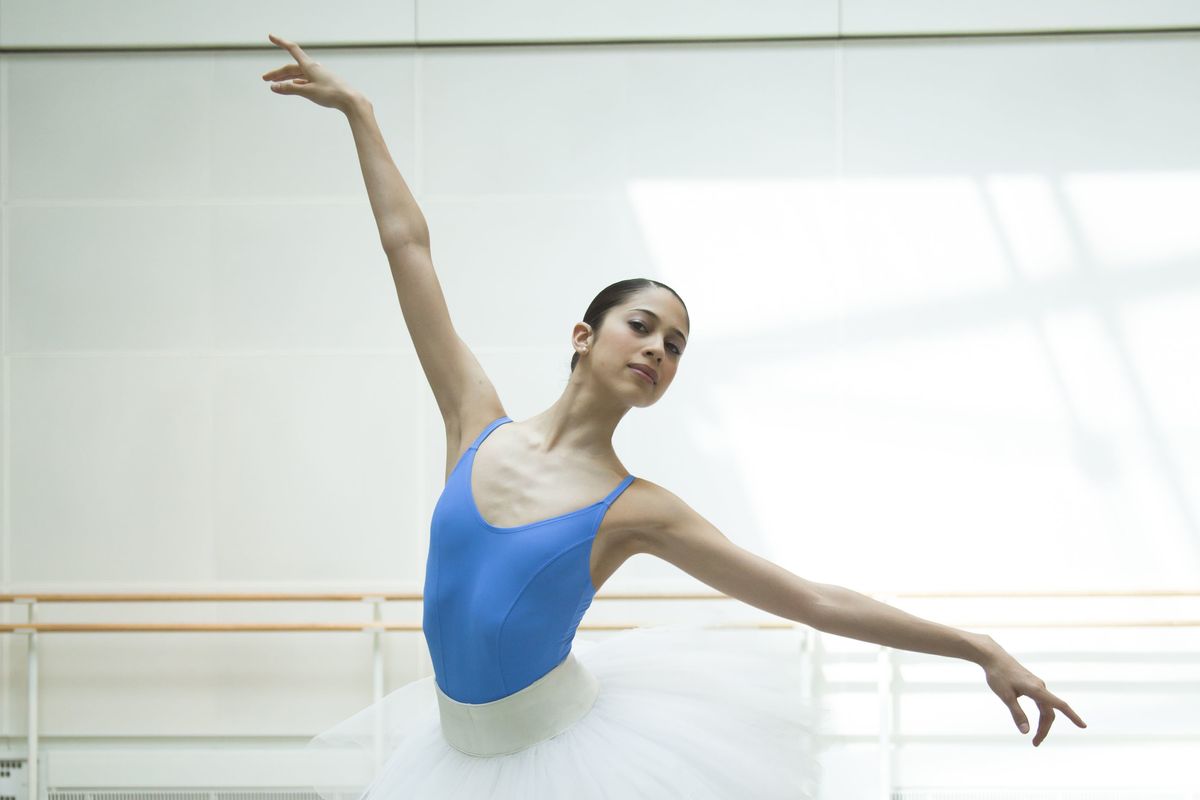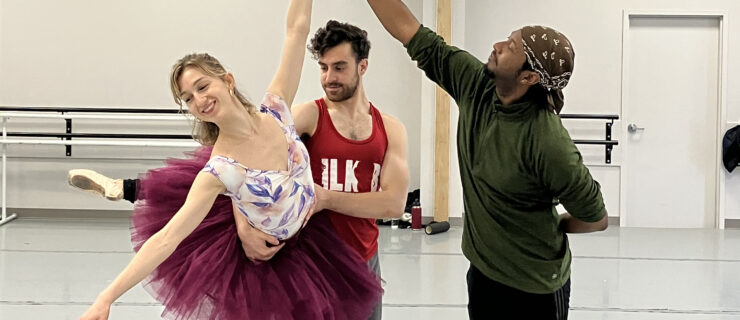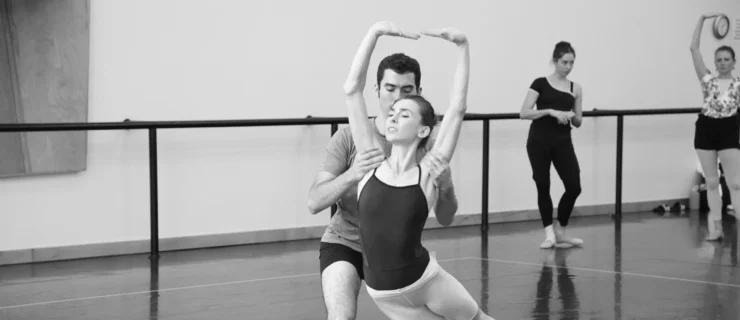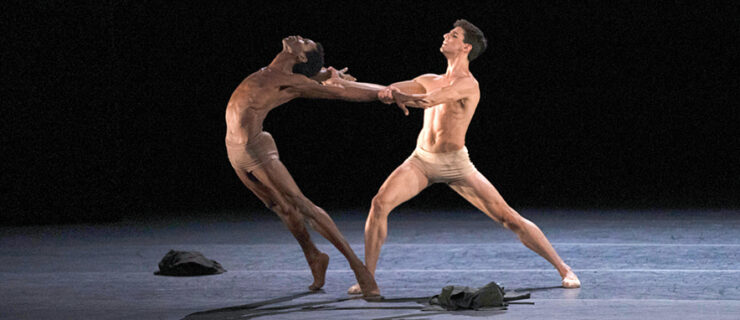A Touch of Magic: American Prodigy Beatriz Stix-Brunell Comes Into Her Own at The Royal Ballet
Beatriz Stix-Brunell is standing in front of the choreographer Christopher Wheeldon, frowning intently. It is early March at The Royal Ballet in London, and just one day before she is due to make an unexpected debut in the title role of his Alice’s Adventures in Wonderland, replacing the injured Marianela Nuñez, one of the company’s most acclaimed ballerinas. As if that weren’t enough pressure, The Royal Ballet is streaming class and rehearsals live online all day, with four camera crews moving between studios.
Wheeldon is fine-tuning (in front of a “worldwide online audience,” as he jokingly puts it) the first step of one of Alice’s solos. It’s an arabesque renversée, in which she must balance for a split second after the turn, before stepping gracefully backwards and repeating the step. After watching Stix-Brunell perform the sequence, Wheeldon gets out of his chair. “Think of somebody taking your arabesque foot and pulling you back,” he tells her, demonstrating the openness and breadth he wants for the movement. Stix-Brunell nods briefly and tries again. It’s a perfect, dreamy fall, arms floating down with exquisite airiness as she turns out of the arabesque.
“Beautiful,” says Wheeldon. “Just three of those would be nice.”
Her Breakout Year
The American-born Stix-Brunell is only 19, but she is no stranger to pressure or the spotlight. At 14, she was already dancing with Wheeldon’s company, Morphoses. At 17, she joined The Royal Ballet. And in a short two years, she has rocketed from Wili-and-sylph obscurity to a slew of principal roles. Over the past year, she has danced Alice, Princess Rose in Kenneth MacMillan’s The Prince of the Pagodas and a principal role in the Wheeldon/Alastair Marriot collaboration, Trespass, part of the “Metamorphosis—Titian 2012″ program that ended last season. In July she was promoted from the most junior rank, artist, to soloist, skipping—very unusually—the intermediary position of first artist.
“Every now and again you break the rules,” says Monica Mason, the just-retired director of The Royal Ballet, who hired Stix-Brunell in 2010.
Stix-Brunell’s path to The Royal Ballet doesn’t seem like an obvious one. In many ways, she is quintessentially American, with the speedy footwork, long limbs and streamlined attack that Balanchine sought in his dancers. But, less characteristically, she has a beautifully pure port de bras and a certain old-fashioned glamour that suits The Royal’s theatrically-driven repertoire.
A Paris Opéra Ballet “Rat”
Growing up in Manhattan, with an interior designer mother and a father in finance, Stix-Brunell enrolled at the School of American Ballet at 7, and was immediately smitten. At 11, she started taking additional classes with the Paris Opéra–trained Fabrice Herrault, an unusual step for such a young dancer, and the first indication of her attraction to a more European aesthetic. “Fabrice would show me videos of the Paris Opéra Ballet School, of Baryshnikov, Gelsey Kirkland,” she says. “I was intrigued by his stories of France, and I decided I would audition for the Paris Opéra Ballet School.”
Stix-Brunell traveled with her mother to the school’s headquarters just outside of Paris. Although the school takes few foreign students, she was accepted. In September 2005, she left her New York private school, Nightingale-Bamford, and moved to Paris with her mother and brother; her father remained behind, visiting when he could.
“It was overwhelming at first,” she says. “Everything, including school lessons, was in French, which I didn’t speak, and the pressure in the ballet classes was high; we had exams and were graded, which I wasn’t used to. And it was difficult to make friends.”
After three months, however, Stix-Brunell was speaking French, loving her ballet classes, taught by the just-retired étoile Elisabeth Maurin, and basking in the sense of tradition that permeated lessons and performances at the Palais Garnier. “I learned so much about the port de bras, the beats and the jumps,” she says. “I think it helped to give me a great foundation for my technique.”
At the end of the year, she was graded first in her class, but decided nonetheless to return to New York. Her brother, about to enter high school, was eager to go home, and she wanted to head back for eighth grade at her old school. She didn’t, however, return to SAB, deciding instead to work with Herrault to further the kind of training she had been getting in Paris. Soon after her arrival in New York, she heard that Wheeldon was auditioning dancers for Morphoses and decided to try her luck.
Making the Morphoses Cut
“It was hard not to notice her. She had a maturity about her, despite her age, and a lovely technique,” says Wheeldon, recalling that first audition. “She did so well in that first season that I asked her to come back for the next one, at the ripe old age of 15.”
Stix-Brunell joined Morphoses full-time, helped by her school. The sight of the young dancer doing her homework between rehearsals became a familiar one to the Morphoses dancers, who included Leanne Benjamin and Edward Watson from The Royal Ballet, and Wendy Whelan and Tiler Peck from New York City Ballet.
While most young dancers might have felt that their careers had been launched, Stix-Brunell agreed with her parents that she should finish high school. She left Morphoses and rejoined SAB, in addition to continuing her classes with Herrault. During that year, she connected with Mason, who, while in town for NYCB’s Choreographic Institute showing, sat in on the women’s advanced class at SAB. Mason knew Stix-Brunell from her time with Morphoses.
“I had been very impressed when I first saw her,” says Mason. “She was a very confident 15-year-old, musical and technically secure, with beautiful arms that give her a feminine, tranquil allure. But I felt she was at SAB and that Peter Martins should have first choice.”
Martins, however, didn’t choose Stix-Brunell for NYCB, and when the dancer put out feelers, Mason didn’t hesitate. During Stix-Brunell’s first year in London, she completed high school via Skype (“Monica gave me two days off to go to the graduation ceremony”) and danced mostly corps de ballet roles. The breakthrough came this past March, when Nuñez was injured, and Wheeldon asked Stix-Brunell to learn Alice. “I basically locked myself in a room every day, learning the whole ballet,” she says. “I lived, slept and breathed the part. I reread the book, I watched the movie; I thought all the time about what I could bring to the role that was my own.”
The calmness, ability to learn quickly and stage experience that she showed through the Alice performances stood her in good stead when another ballerina, Lauren Cuthbertson, had to withdraw from The Prince of the Pagodas just weeks later. “She has proved how capable she is, and how cool under pressure, which is hugely important when you have to get something big together,” says Mason.
The British critics have so far been mostly noncommittal about Stix-Brunell. “With her willowy limbs, she has an easy flow to her dancing, and like many Americans she has a very open line which looks more relaxed in comparison with her European counterparts,” says Debra Craine, the chief dance critic of the London Times. “She didn’t look at all fazed by being thrown into the lead in Wheeldon’s Alice, but I think, as yet, she lacks a sense of dramatic projection and The Royal is a company that really values a vivid theatrical personality in its ballerinas.”
As Wheeldon points out, Stix-Brunell’s quick rise through the ranks may bring with it a certain amount of pressure. “She is not in an easy position among her peers,” he says. “But what impresses me is her steadfast determination to focus on her career.”
Stix-Brunell herself claims to be “friendly with everyone” and to enjoy her life in London, living alone near Covent Garden, attending as many theater and dance performances as possible and going to museums on her rare off-days. Does she miss the normal life of a teenager?
“For dance you have to make sacrifices,” she says. “I’m doing something I adore every day. We work hard, and the reward is being on stage.”





